Menus
- Turbo classic
- KKK charger comes from a Porsche bi-turbo racing car
- It doesn’t matter, the main thing is that the box rolls first
- The goal of the boxer upgrade: to be faster than Japan’s big bikes
- From 6000 rpm the BMW K 100 RS becomes a cannonball
- Turbo recipe is actually very simple
- Technical specifications
- Sauerborn-Munch TTS 1200 Turbo
- Support BMW K 100 RS Turbo
- Opinions
- Fred Siemer, MOTORRAD Classic employee
- Martin Stegemann, owner of Turbo-Munch
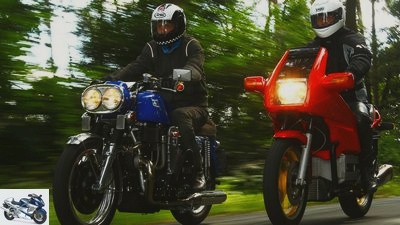
Jacek Bilski
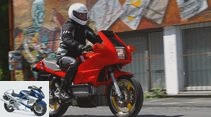
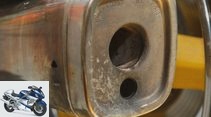
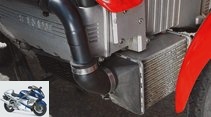
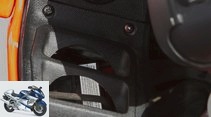
21st photos
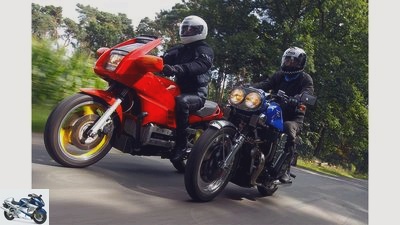
Jacek Bilski
1/21
In the early 1980s, the Japanese thought that turbochargers would go best with small engines. Two German inventors had long since proven that things have to be done much bigger.
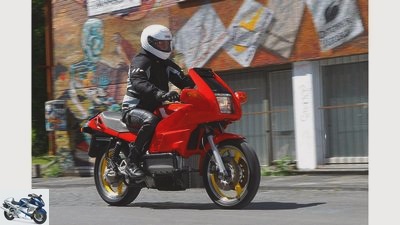
Jacek Bilski
2/21
Support BMW K 100 RS Turbo.
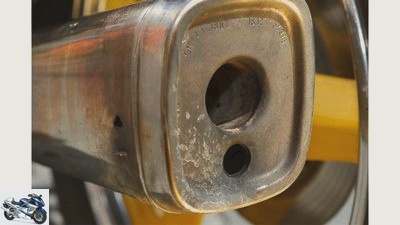
Jacek Bilski
3/21
Anyone who has been overtaken by a completely normal looking K 100 RS with two holes in the pot can relax: That was a support turbo.

Jacek Bilski
4/21
An effective intercooler is extremely important in turbo engines for high performance.
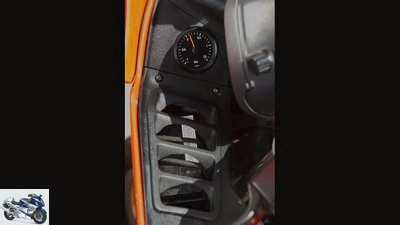
Jacek Bilski
5/21
After gentle use, the loader quickly builds up to 0.65 atmospheric pressure from 6000 rpm.
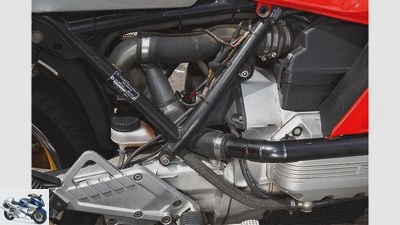
Jacek Bilski
6/21
Siegfried Stutz hid the loader in the frame triangle, and that’s why the seat heats up noticeably when you stroll around. The air is pressed into the series filter box.
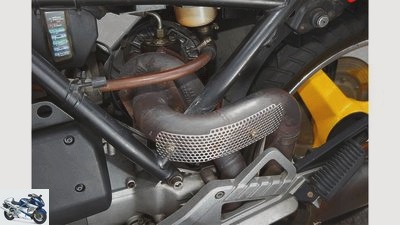
Jacek Bilski
7/21
Thanks to Turbo, the gentle K 100 RS became an almost unattainable high-speed burner.
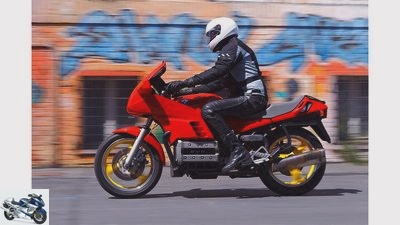
Jacek Bilski
8/21
Support BMW K 100 RS Turbo.
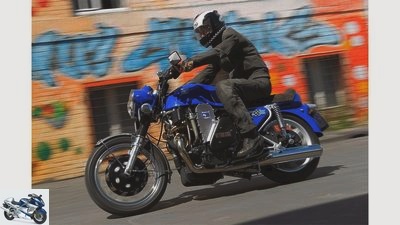
Jacek Bilski
9/21
Sauerborn-Munch TTS 1200 Turbo.
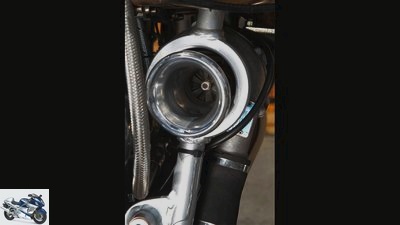
Jacek Bilski
10/21
The charger draws in the air through this funnel and then shovels it into the collector.

Jacek Bilski
11/21
Namely the red support BMW K 100 RS Turbo with 987 cm³ displacement and the blue Sauerborn-Munch TTS 1200 Turbo with a displacement of 1188 cm³.
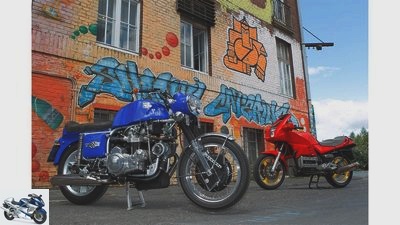
Jacek Bilski
12/21
This makes the Sauerborn-Munch TTS 1200 Turbo to 110 hp
at 6000 rpm, the support BMW K 100 RS Turbo comes to 140 hp at 8000 rpm.
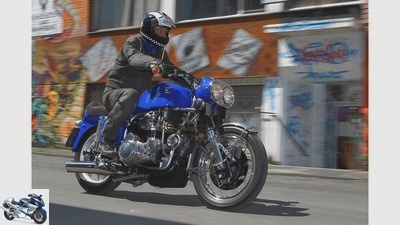
Jacek Bilski
13/21
With the help of a turbocharger, Munch was supposed to reconnect with the big bikes of the 1970s.
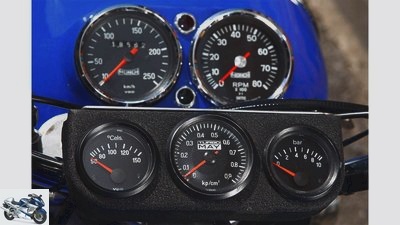
Jacek Bilski
14/21
The KKK turbocharger kicks in softly at less than 4000 revs, and depending on the load, it will soon deliver its maximum boost pressure of 0.4 atmospheres.
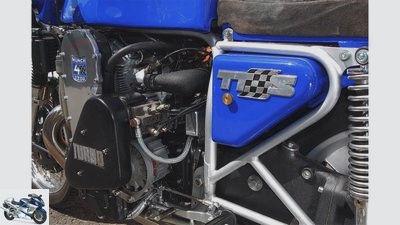
Jacek Bilski
15/21
In front of the cylinder is the turbo, behind it the injection system: the Arno-Munch is narrow.
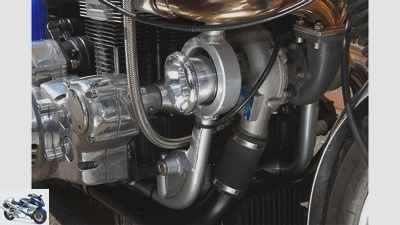
Jacek Bilski
16/21
Sauerborn-Munch TTS 1200 Turbo.
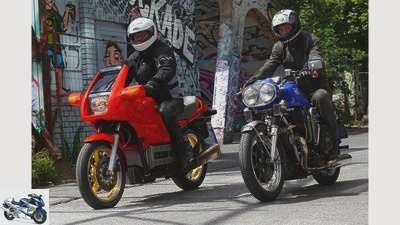
Jacek Bilski
17/21
Sauerborn-Munch TTS 1200 Turbo and support BMW K 100 RS Turbo on tour.
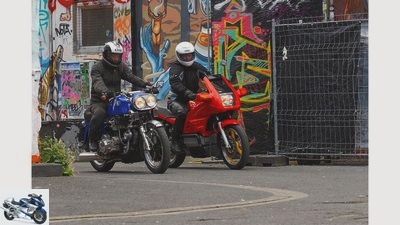
Jacek Bilski
18/21
"The first turbo of my life was in my Citroën Berlingo Diesel, and so far I was firmly convinced that such a loader belonged right there, namely in the engine compartment of a van. Okay, there was still a need for clarification about the storage location directly under the bench after a dull inner-city photo trip with the Turbo-K 100 RS. But other than that, after this brief encounter, I only have admiration. …
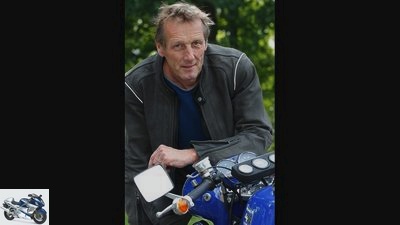
Jacek Bilski
19/21
Martin Stegemann, owner of Turbo-Munch: "I like to drive, but modern motorcycles are also good for driving. The older ones add something else. The attraction is to keep your classic technology running. To get going again. To understand. Konigswellen-Ducati, Vincent, Munch – these are the names of my favorites from this point of view, and they present every restorer with real challenges. …
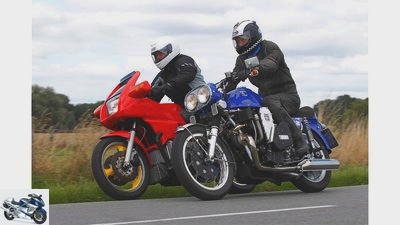
Jacek Bilski
20/21
… A Munch is in itself the opposite of large-scale production, there are parts that Friedel designed on a good day, and there are others. Add to that the courageous conversions by Arno Sauerborn and then the story: from first owner! It doesn’t really exist anymore. So, and when this thing drove again at all, it was a very, very nice moment."
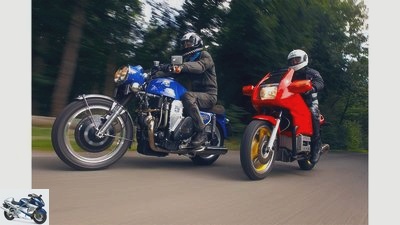
Jacek Bilski
21/21
Sauerborn-Munch TTS 1200 Turbo and support BMW K 100 RS Turbo on tour.
On the move with Sauerborn-Munch TTS 1200 Turbo and support BMW K 100 RS Turbo
Turbo classic
Content of
In the early 1980s, the Japanese thought that turbochargers would go best with small engines. Two German inventors had long since proven that things have to be done much bigger. A tour with the two turbocharged bikes Sauerborn-Munch TTS 1200 Turbo and support BMW K 100 RS Turbo.
B.Today, large valves, lush cams, greedy funnels and fat carburettors are considered useful answers to the eternal question of how to make as much mixture pop as possible. Alfred Buchi preferred more radical solutions as early as 1905. The resourceful Swiss did not want to see that in internal combustion engines, far more than half of the energy escapes through the exhaust. Useless!
Buy complete article
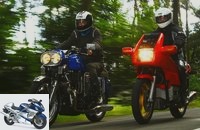
On the move with Sauerborn-Munch TTS 1200 Turbo and support BMW K 100 RS Turbo
Turbo classic
BMW brought the 2002 turbo into series production in 1973
The motorcycle world in the early boom years had absolutely no inkling of this, even the turbocharged engines from MAN or Volvo, which have been successfully on the road since the early 50s, were dieseling to themselves. Then, however, the automobile athletes switched on the turbo, namely the wide-tire, soon 280-hp 02-series BMWs from Dieter Quester and Hubert Hahne taught that Buchi’s ideas could not only upgrade trucks and boats, but also sports equipment.
Michael May’s work was also well received, as the ex-racing driver turned staid Ford V6s into 180-hp roars. BMW brought the 2002 turbo into series production in 1973, Porsche and Saab followed in 1975 with the 911 and 99 Turbo. At the time, Arno Sauerborn had long owned a motorcycle that actually didn’t even have to fear a charged sports car. In the late summer of 1970 he bought a TTS 1200 from Friedel Munch. He wasn’t allowed to pick it up until early autumn, because Friedel needed number 128 quickly for IFMA beforehand.
KKK charger comes from a Porsche bi-turbo racing car
But then it was over with shows, because the Rhineland car mechanic had honestly worked out his dream machine – and was now demanding honest consideration. Many tours through and far beyond the Alps welded together, man and machine even defied icy winters due to the lack of a car. That didn’t stop Sauerborn from getting interested in touring car racing and the like. It was unbelievable what these boxes were pushing, and with alluringly simple means. When all the later big bikes from Kawasaki, Honda or Laverda were nibbling on the nimbus of his mammoth, he decided in 1975 to push the nominal 88 hp Munch TTS forward using a loader.
Said and done. A loader like the one May used was quickly found. The acquired theoretical tools required that the turbo be placed as close as possible to the exhaust tract because of the shorter response time. Keyword: turbo lag. Too bad that the frame tubes ran at a suitable point. But wait! What if you cut it open and then welded two stable circular segments into place? The idea was too tempting, the frame of the Munch – today a sacrilege – came under the knife. Ultimately, a KKK charger, which originally came from a Porsche bi-turbo racing car, found its place in said segments. It blew a tame 0.4 atmospheric air into a self-formed and built aluminum sheet collector in front of the two standard Weber double carburetors. Because turbo engines cannot withstand as high a compression as suction cups, Sauerborn got the cylinder head of a completely normal NSU 1200 and swapped it for the 1200 TT head used by Munch. Instead of a sharper TTS camshaft, he used that of the TT.
Jacek Bilski
Thanks to Turbo, the gentle K 100 RS became an almost unattainable high-speed burner.
The whole thing, the builder still swears today, actually worked quite well from the start, only the carburetor tuning was always tricky. With higher boost pressure it even dented the swimmers. Overall, the condition was not satisfactory, and so he remembered the master’s work: in 1973 Friedel Munch had installed a mechanical Kugelfischer injection system. Seven years later, Arno Sauerborn followed suit and obtained something comparable from a BMW 2002 ti. Since then, his Sauerborn-Munch TTS 1200 Turbo only needs seven liters instead of initially ten liters, and thanks to Turbo it runs as fast as it should always have run. Good 200.
Not an issue today for the machine freshly and completely restored by Martin Stegemann, the current owner. Because of the air collector – now made of GRP – the four-cylinder babbles less briskly than with a funnel-equipped series Munch, but still self-confidently. Now reduce your fear of the equally precious and heavy part, concentrate briefly and pull the clutch. Slips. Namely, it has been converted to hydraulics by Arno Sauerborn.
It doesn’t matter, the main thing is that the box rolls first
Which does not mean that it comes without a slight plucking. It doesn’t matter, the main thing is that the box rolls first. Then it becomes more normal with every meter, irritated during the short exit only in tight bends with wobbly turning behavior that takes some getting used to. And below 2000 revs, Stegemann is still working on that, with the engine running smoothly.
What could be mitigated by enriching the mixture a little with a lever, but fumbling around now would be reckless, as on the very first Munch tour. Incidentally, the builder only used this lever on the motorway. What the heck, from 4000 rpm there is nothing more to complain about, as the turbo provides very convincing thrust. Thanks to the “longer” secondary ratio, third gear is sufficient for sovereign country road tours.
The goal of the boxer upgrade: to be faster than Japan’s big bikes
Siegfried Stutz never thought much of touring mode. Thanks to water injection and a boost pressure of up to 1.6 atmospheres, his Turbo-Munch released 180 hp at short notice, which was of course history when Arno Sauerborn just started the first test runs. Burned down. Because a spark sparkled close to the carburetor in the narrow space under the tank. It was hot there anyway, because Stutz had left the frame completely and instead placed the turbo under the seat. So the carburetors caught fire, shortly afterwards the numerous magnesium components of the Munch, a heap of ash remained. From the dream? Not because of: the Palatinate inventor found supercharging so turbo-charged that he made a new victim in 1977 with the BMW R 100 S. The goal of the boxer upgrade: to be faster than Japan’s big bikes.
Support made it. And so the scene was so impressed that he made a living out of this form of tuning. Spiced up BMWs were built in rows in Herxheim near Landau, and it wasn’t until 2006 that he closed his business. The support BMW K 100 RS Turbo shown in this story, built in 1987, dates from its heyday. Here, too, the charger sits under the seat, the battery moved to the seat hump. Only the unusual exhaust pipe and the intercooler attached below in front of the engine reveal the conversion. The latter comes from Lengerer & Rich, was originally supposed to refresh a Fiat Uno Turbo and already suggests that this is the point. Although Stutz initially only received a clearance certificate from BMW for the K chassis for 100 hp, he experimented with significantly higher performance from the start, and after a long struggle it was officially registered. 140 hp in the present case, and the intake air should then be pretty cool and ready for oxygen.
From 6000 rpm the BMW K 100 RS becomes a cannonball
The tried-and-tested KKK loader blows in quite a civilian 0.65 atmospheric pressure, but tamer cam profiles and pistons with flatter bottoms were required. The control electronics also underwent major changes in order to adapt the injection quantity to the drastically changed air quantities. Thanks to a knowledgeable friend, Siegfried Stutz achieved his goal here more easily than Arno Sauerborn, who had to process the space cam of his mechanical injection himself. In the BMW K 100 RS Turbo, too, the extra power required adapted gear ratios. A new primary drive, “long” fifth gear and final gear ratio should be enough to keep the speed in an acceptable range. The charging configured by him for customer vehicles, as Siegfried Stutz has known for a long time, does not damage the engine at all. But because of the extra power easily achievable overspeed, which could seriously threaten the crankshaft and its bearings without gear ratio changes.
A few minutes later it becomes clear what is meant: After the support BMW K 100 RS Turbo is still pretending to start a career as a government agency tomorrow, it reveals itself to be the ideal getaway vehicle in the open. The nicest thing: there is no deep turbo lag between the two types that would turn overtaking into a risky game, no punch in the back that overstrains the rear wheel when accelerating out of curves. From 4000 rpm the turbo unfolds its beneficial work noticeably, but gradually, from 6000 rpm it turns the good K into a cannonball.
Turbo recipe is actually very simple
At lightning speed it turns towards the red area at 8500 rpm, so fast that even experienced friends of the flying brick forget to switch gears out of sheer shock and continue to stare at the instrument needle in disbelief. Phew, everything started so familiarly: stable, quietly whimpering idle as always. Transmission, well, as always. The engine interventions in the lower speed range cost a touch of pulling power, a little spontaneity, but that’s a fair price for the added value offered around the top.
Relatively large loaders and relatively large engines, that makes great turbo motorcycles. The Sauerborn-Munch TTS 1200 Turbo proclaims this simple recipe in a lovable and original way, the support BMW K 100 RS Turbo with subtle persuasiveness. Both raise the question of why the Japanese had to try it with, in some cases, significantly smaller engines around 1980. Siegfried Stutz is convinced that Nippon’s engineers also knew the right recipe. But that they didn’t want to jeopardize the commercial success of their recently released big bikes. Could be true.
Technical specifications
Jacek Bilski
Sauerborn-Munch TTS 1200 Turbo and support BMW K 100 RS Turbo.
Sauerborn-Munch TTS 1200 Turbo
Jacek Bilski
Sauerborn-Munch TTS 1200 Turbo.
Sauerborn-Munch TTS 1200 Turbo
Engine: transversely installed, air-cooled four-cylinder four-stroke in-line engine, one overhead camshaft, two valves per combustion chamber operated via rocker arms, bore x stroke 75 x 66.6 mm, displacement 1188 cm³, mechanically controlled injection system, turbocharger with a maximum boost pressure of 0.4 atm Power about 110 hp at 6000 rpm
Power transmission: Hydraulically operated multi-plate dry clutch, four-speed gearbox, secondary drive via fully encapsulated chain
Landing gear: Double loop frame made of tubular steel, Munch telescopic fork at the front, electron double-arm swing arm with integrated chain case and two spring struts at the rear, wire-spoke wheel at the front, cast wheel at the rear, front tires 3.25 V 19, rear 4.00 V 18, front duplex brake, Ø 250 mm, hydraulically operated duplex Rear brake, Ø 250 mm
Mass and weight: Wheelbase 1460 mm, weight approx. 300 kg with a full tank, tank capacity 28 liters
Driving performance: Top speed around 210 km / h
Info: Martin Stegemann, phone 0176/47 33 25 27
Support BMW K 100 RS Turbo
Jacek Bilski
Support BMW K 100 RS Turbo.
Support BMW K 100 RS Turbo
Engine: longitudinally installed, water-cooled four-cylinder four-stroke in-line engine, two overhead camshafts, two valves per combustion chamber operated via bucket tappets, bore x stroke 67 x 70 mm, displacement 987 cm³, electronically controlled injection system, turbocharger with a maximum of 0.65 atm boost pressure, output 140 hp at 8000 rpm
Power transmission: Mechanically operated single-disc dry clutch, five-speed gearbox, cardan drive
Landing gear: Bridge frame made of steel tubes, telescopic fork at the front, single-sided swing arm with integrated cardan tunnel and rear shock absorber, PVM cast wheels, front tires 100/90 VR 18, rear 140/80 VR 17, double disc brake with fixed calipers at the front, Ø 300 mm, disc brake with fixed caliper at the rear, Ø 285 mm
Mass and weight: Wheelbase 1516 mm, weight approx. 280 kg with a full tank, tank capacity 21 l
Driving performance: Top speed over 240 km / h
Opinions
Jacek Bilski
Sauerborn-Munch TTS 1200 Turbo and support BMW K 100 RS Turbo.
Fred Siemer, MOTORRAD Classic employee
Jacek Bilski
Fred Siemer, MOTORRAD Classic employee.
The first turbo of my life was in my Citroën Berlingo Diesel, and so far I was firmly convinced that such a loader belonged right there, namely in the engine compartment of a van. Okay, after a slow inner-city photo trip with the support BMW K 100 RS Turbo, there was still a need for clarification about the storage location directly under the bench. But other than that, after this brief encounter, I only have admiration. First, there is the incredible pressure with which the four-cylinder revs up at lightning speed. But this will to perform is all the more impressive because it is presented in a civilized and predictable manner, because it fits seamlessly into the noble overall picture of BMW. With a loader, I think it’s really upper class.
Martin Stegemann, owner of Turbo-Munch
Jacek Bilski
Martin Stegemann, owner of Turbo-Munch.
I like to drive, but modern motorcycles are also good for driving. The older ones add something else. The attraction is to keep your classic technology running. To get going again. To understand. King shaft Ducati, Vincent, Munch – these are the names of my favorites from this point of view, and they pose real challenges for every restorer. A Munch is in itself the opposite of large-scale production, there are parts that Friedel designed on a good day, and there are others. Add to that the courageous conversions by Arno Sauerborn and then the story: from first owner! It doesn’t really exist anymore. So, and when this thing drove again at all, it was a very, very nice moment.
Related articles
-
Comparison test: Honda CX 500-650 Turbo, Kawasaki Z 750 Turbo, Suzuki XN 85, Yamaha XJ 650 Turbo
Jahn 21 pictures Jahn 1/21 The preload of the central spring strut of the Suzuki can be easily adjusted. Jahn 2/21 Tight corners and fast …
-
On the move: Harley-Davidson XR 1000-XR 1200
fact On the move: Harley-Davidson XR 1000 / XR 1200 Sportsmanship Content of Harley-Davidson and sporty motorcycles – despite the Sportster models, these…
-
Zonko’s attack on the Ducati Monster 1200 R
andreasriedmann.at 14 pictures andreasriedmann.at 1/14 Ducati Monster 1200 R. andreasriedmann.at 2/14 With the monster it can be robbed properly ….
-
Impression BMW R 100 RS and R 1200 RS
Bilski 25 pictures Bilski 1/25 Characteristic to this day: the front of the world’s first series full fairing. In contrast, the new RS looks much more arbitrary …
-
On the move: 30 years of GS models from BMW
Frank Herzog 71 photos BMW 1/71 1985: Little Gaston Rahier fights his way through the desert again with his huge HPN boxer and can successfully defend…
-
On the move with the Muller-Yamaha XS 400T
Fred Siemer 16 photos Fred Siemer 1/16 Yamaha XS 400T Fred Siemer 2/16 Yamaha XS 400T. Fred Siemer 3/16 Yamaha XS 400T. Fred Siemer 4/16 The compact twin…
-
Artistic top test BMW R 1200 R double whopper Classic, but modern. Cruise casually or alternatively drive sportily? in the new BMW R 1200 R …
-
Honda GL 1000 Gold Wing and Munch-4 TTS-E 1200
fact 35 pictures fact 1/35 Honda GL 1000 Gold Wing and Munch-4 TTS-E 1200. fact 2/35 Nevertheless, the Munch is not as impassable as feared. Actually…
-
Siemer On the move: Moto Guzzi V7 steam announcement Contents of No teeth in the mouth, but La Paloma whistle: This is how it looked when Moto Guzzi despite the highest …
-
Honda CB 750 Four, Munch-4 1200 TTS, MV Agusta 750 S.
Jahn 33 photos Jahn 1/33 It couldn’t be any more engine: with its transversely installed four-cylinder in-line engine, the Honda CB 750 caused a…